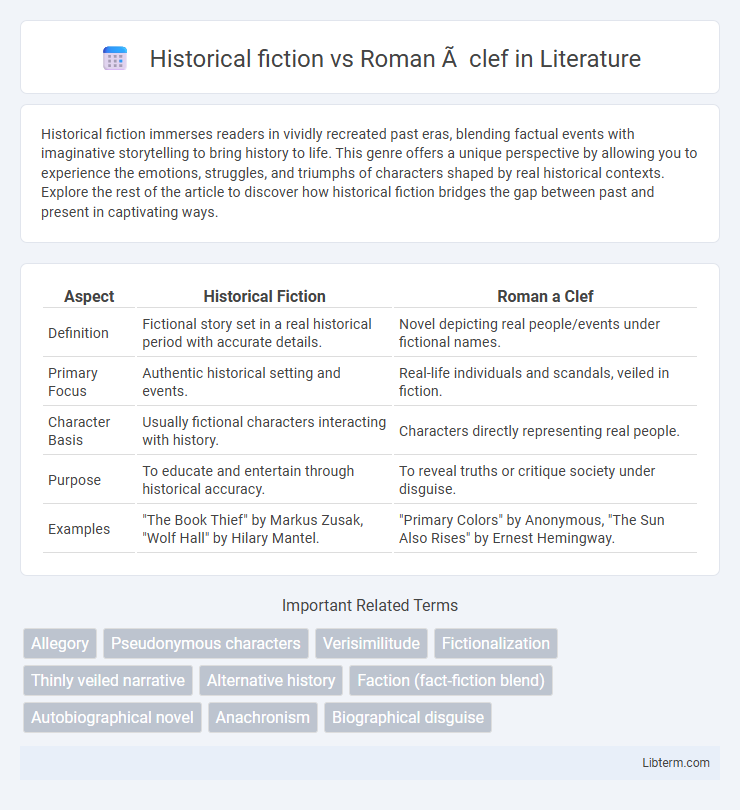Historical fiction immerses readers in vividly recreated past eras, blending factual events with imaginative storytelling to bring history to life. This genre offers a unique perspective by allowing you to experience the emotions, struggles, and triumphs of characters shaped by real historical contexts. Explore the rest of the article to discover how historical fiction bridges the gap between past and present in captivating ways.
Table of Comparison
| Aspect | Historical Fiction | Roman a Clef |
|---|---|---|
| Definition | Fictional story set in a real historical period with accurate details. | Novel depicting real people/events under fictional names. |
| Primary Focus | Authentic historical setting and events. | Real-life individuals and scandals, veiled in fiction. |
| Character Basis | Usually fictional characters interacting with history. | Characters directly representing real people. |
| Purpose | To educate and entertain through historical accuracy. | To reveal truths or critique society under disguise. |
| Examples | "The Book Thief" by Markus Zusak, "Wolf Hall" by Hilary Mantel. | "Primary Colors" by Anonymous, "The Sun Also Rises" by Ernest Hemingway. |
Defining Historical Fiction
Historical fiction is a literary genre that reconstructs past events, blending factual history with imaginative storytelling to create authentic settings and characters. Unlike Roman a clef, which veils real-life figures and occurrences behind fictional names and narratives, historical fiction aims to immerse readers in a specific era through meticulously researched details. This genre prioritizes historical accuracy while allowing creative freedom to explore the social, political, and cultural atmospheres of the time.
Understanding Roman à Clef
Roman a clef is a genre of historical fiction that features real-life events and figures disguised under fictional names, allowing readers to decode true stories through symbolic characters and narratives. Unlike traditional historical fiction that emphasizes accurate historical settings and details, Roman a clef blends fact with fiction to explore personal and political realities covertly. Understanding Roman a clef involves recognizing the subtle interplay between actual experiences and imaginative storytelling, which often critiques or reveals hidden truths about historical events or personalities.
Key Differences Between the Genres
Historical fiction reconstructs past events with a focus on accuracy and immersive settings, blending real historical figures and genuine events with fictional elements. Roman a clef disguises real people and incidents under fictional names and narratives, often revealing truths about contemporary society or insiders through allegory. The crucial difference lies in historical fiction's dedication to authentic representation versus roman a clef's use of fiction as a veiled commentary on real-life subjects.
Origins and Evolution of Historical Fiction
Historical fiction originated in the early 19th century with authors like Sir Walter Scott, blending factual history with imaginative storytelling to bring past eras vividly to life. This genre evolved to prioritize accurate historical settings and character development while weaving fictional narratives around real events, enhancing readers' engagement with history. Roman a clef similarly emerged within this literary context but distinguishes itself by depicting real people and events under fictional names, offering veiled insight into true stories while maintaining a narrative guise.
The Rise of Roman à Clef in Literature
The rise of Roman a clef in literature marked a shift towards blending real-life figures with fictional narratives, offering readers an engaging interplay between history and imagination. Unlike traditional historical fiction, which emphasizes accurate period detail and contextual realism, Roman a clef uses coded characters and events to critique or reveal contemporary social and political issues. This genre gained prominence in the 20th century as authors sought to bypass censorship and offer insider perspectives on influential personalities through allegorical storytelling.
Narrative Techniques Compared
Historical fiction employs detailed contextual world-building and authentic period dialogue to immerse readers in accurately depicted bygone eras. Roman a clef integrates real-life events and figures through thinly veiled characters, blending factual inspiration with fictionalized narrative, often using allegory and symbolism. Both genres utilize shifting perspectives and temporal structures but differ in transparency of source material and authorial intent.
Realism and Artistic License
Historical fiction prioritizes detailed accuracy in settings, events, and character portrayal to create an immersive and believable narrative rooted in researched facts. Roman a clef employs artistic license by fictionalizing real people and events under pseudonyms, blending reality with imaginative storytelling to explore truth beyond mere historical accuracy. The balance between realism and artistic interpretation in these genres shapes readers' engagement with history and personal truth.
Famous Works: Historical Fiction vs. Roman à Clef
Historical fiction features renowned works like Hilary Mantel's *Wolf Hall* and Ken Follett's *The Pillars of the Earth*, which vividly recreate past eras with meticulous research and factual settings. Roman a clef novels, such as Truman Capote's *Answered Prayers* and Evelyn Waugh's *Scoop*, veil real-life figures and events behind fictional characters and fictionalized narratives. Both genres blend imagination with reality but differ distinctly in their approach to historical accuracy and narrative transparency.
Reader Engagement and Expectations
Historical fiction immerses readers in meticulously researched past settings, blending real events with fictional characters to evoke a vivid sense of time and place, fostering deep emotional connections and curiosity about history. Roman a clef offers a layered narrative where readers seek to decode real-life identities behind fictionalized portrayals, engaging intellectually through recognition and speculation. Reader expectations differ as historical fiction demands authenticity and immersive storytelling, while Roman a clef relies on insider knowledge and interpretive engagement to uncover hidden meanings.
Which Genre Is Right for Your Story?
Historical fiction immerses readers in accurately researched settings with fictional characters or events, ideal for stories aiming to bring past eras to life with creative freedom. Roman a clef blends real-life people and events disguised under fictional names, perfect for narratives exploring personal or controversial subjects through allegory. Choosing between these genres depends on whether you want to emphasize historical accuracy with imaginative storytelling or reveal real experiences through symbolic fiction.
Historical fiction Infographic

 libterm.com
libterm.com